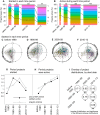The diversity and evolution of ecological and environmental citizen science
- PMID: 28369087
- PMCID: PMC5378328
- DOI: 10.1371/journal.pone.0172579
The diversity and evolution of ecological and environmental citizen science
Abstract
Citizen science-the involvement of volunteers in data collection, analysis and interpretation-simultaneously supports research and public engagement with science, and its profile is rapidly rising. Citizen science represents a diverse range of approaches, but until now this diversity has not been quantitatively explored. We conducted a systematic internet search and discovered 509 environmental and ecological citizen science projects. We scored each project for 32 attributes based on publicly obtainable information and used multiple factor analysis to summarise this variation to assess citizen science approaches. We found that projects varied according to their methodological approach from 'mass participation' (e.g. easy participation by anyone anywhere) to 'systematic monitoring' (e.g. trained volunteers repeatedly sampling at specific locations). They also varied in complexity from approaches that are 'simple' to those that are 'elaborate' (e.g. provide lots of support to gather rich, detailed datasets). There was a separate cluster of entirely computer-based projects but, in general, we found that the range of citizen science projects in ecology and the environment showed continuous variation and cannot be neatly categorised into distinct types of activity. While the diversity of projects begun in each time period (pre 1990, 1990-99, 2000-09 and 2010-13) has not increased, we found that projects tended to have become increasingly different from each other as time progressed (possibly due to changing opportunities, including technological innovation). Most projects were still active so consequently we found that the overall diversity of active projects (available for participation) increased as time progressed. Overall, understanding the landscape of citizen science in ecology and the environment (and its change over time) is valuable because it informs the comparative evaluation of the 'success' of different citizen science approaches. Comparative evaluation provides an evidence-base to inform the future development of citizen science activities.
Conflict of interest statement
Figures



References
-
- Pocock MJO, Roy HE, Preston CD, Roy DB. The Biological Records Centre: a pioneer of citizen science. Biol J Linn Soc. 2015;115: 475–493.
-
- Bonney R, Cooper C, Ballard H. The theory and practice of Citizen Science: Launching a new journal. Citiz Sci Theory Pract. 2016;1.
-
- Parliamentary Office of Science And Technology (POST). Environmental Citizen Science. London, UK: Houses of Parliament, Parliamentary Office of Science & Technology; 2014.
MeSH terms
LinkOut - more resources
Full Text Sources
Other Literature Sources

